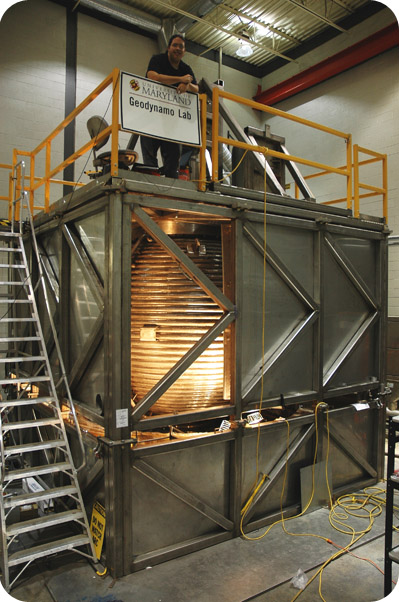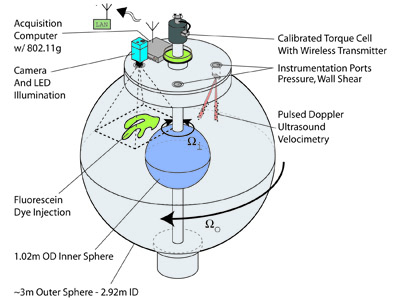Overview
 The Three Meter apparatus is the latest in a series
of experiments designed to study highly turbulent magnetohydrodynamic flow in the laboratory, and
We hope that this apparatus will have sufficiently high input power and sufficiently large size to finally observe
a continuous turbulent fluid dynamo in a geometry similar to Earth's core.
The Three Meter apparatus is the latest in a series
of experiments designed to study highly turbulent magnetohydrodynamic flow in the laboratory, and
We hope that this apparatus will have sufficiently high input power and sufficiently large size to finally observe
a continuous turbulent fluid dynamo in a geometry similar to Earth's core.
The apparatus has a number of features that we hope will maximize our chances of achieving a laboratory dynamo in a simple geometry. The large size and highly electrically conductive sodium metal limit the resistive diffusion of field out of the apparatus, and the high input power will allow us to reach the high flow velocities likely required to sustain the dynamo. Astrophysical objects are generally rapidly rotating, and the strong Coriolis effects that ensue are likely relevant to the dynamo process in those objects. Therefore, the outer vessel of the apparatus was designed to rotate at high speed, driven independently from the inner spherical boundary. We hope that the interplay of turbulence, rotation, and magnetic field will allow us to achieve self-sustaining, dynamic magnetic field generation.
Due to the unique size and design features of the 3m apparatus, we are also able to reach a unique region of purely hydrodynamic parameter space when we fill the device with a nonconductive fluid. Experiments run with water as the working fluid are also a good mechanical test of the experiment before we fill it with sodium metal. Since 2008, we have run a number of experiments, some studying rotating shear flow in the world's largest spherical Couette apparatus and others that investigate the precession driven flow resulting as the axis of the rapidly rotating experiment changes direction in space with the rotation of the Earth. These experiments have been interesting in their own right, and also give us insight into the basic state flow that will arise in the eventual magnetohydrodynamic experiment.
The experimental setup

The 3m apparatus consists of two independently rotatable stainless steel spheres with a radius ratio of 0.35. The outer sphere, 2.92m in inner diameter, has a 2.5cm thick non-ferromagnetic stainless steel wall and is mounted on a pair of bearings in a strong frame. The inner sphere, 1.02m in diameter, is mounted on a shaft supported by bearings in the outer sphere. Each sphere is driven by a variable speed 250kW electric motor. The outer sphere is capable of rotation at 4 revolutions per second, and the inner up to about 15 revolutions per second. Fluid fills the annular gap between the spheres, a volume of about 13,500L. Ports through the outer sphere top lid allow direct access to the fluid. In the currently active hydrodynamic experiments, we have pressure, temperature, ultrasound transducers, and wall shear stress sensors installed in these ports. Batteries power a rotating computer and ultrasound velocimetry device that acquire the signals from these sensors and wirelessly transmit that data to the lab frame. We have LED illumination and a video camera in one instrumentation port for visualization experiments with water as the working fluid. The rotating computer will also acquire the signals from an array of Hall effect magnetic field sensors on the surface of the outer sphere when we make the transition to magnetohydrodynamic experiments.
Theses
- Anthony Mautino, Inverse spectral methods in acoustic normal mode velocimetry of high Reynolds number spherical couette flows, MS Thesis, UMD 2016
- Matthew Adams, Magnetic and acoustic investigations of turbulent spherical flow, UMD 2016
- Santiago A. Triana, Inertial waves in a laboratory model of the Earth's core,UMD 2010
-
Daniel S. Zimmerman, Turbulent shear flow in a rapidly rotating spherical annulus,UMD 2010
Corrected Torque Transducer Schematic: replaces p. 310
Publications
- D.S. Zimmerman, S.A. Triana, H.-C. Nataf and D.P. Lathrop. A turbulent, high magnetic Reynolds number experimental model of Earth's core. Journal of Geophysical Research (Solid Earth). 119: 4538-4557 (2014). [DOI] [ADS]
- M. Rieutord, S.A. Triana, D.S. Zimmerman and D.P. Lathrop. Excitation of inertial modes in an experimental spherical Couette flow. Physical Review E. 86 (2) (2012). [DOI] [ADS] [arXiv]
- S.A. Triana, D.S. Zimmerman and D.P. Lathrop. Precessional states in a laboratory model of the Earth's core. Journal of Geophysical Research. 117 (B4) (2012). [DOI] [ADS]
- D.S. Zimmerman, S.A. Triana and D.P. Lathrop. Bi-stability in turbulent, rotating spherical Couette flow. Physics of Fluids. 23 (6): 065104 (2011). [DOI] [ADS] [arXiv]
